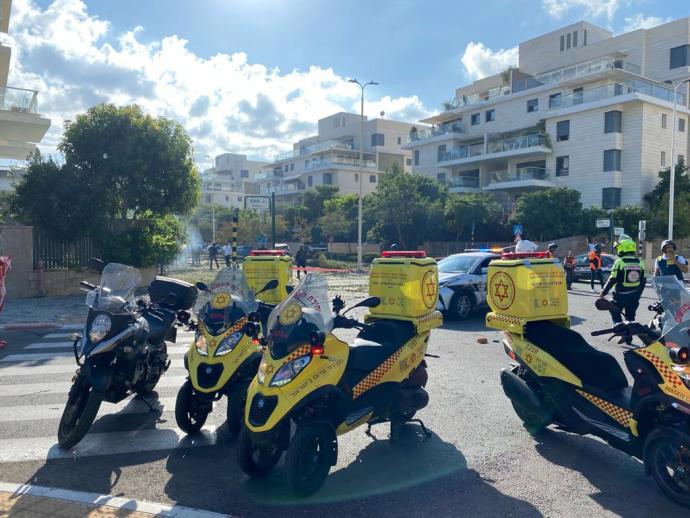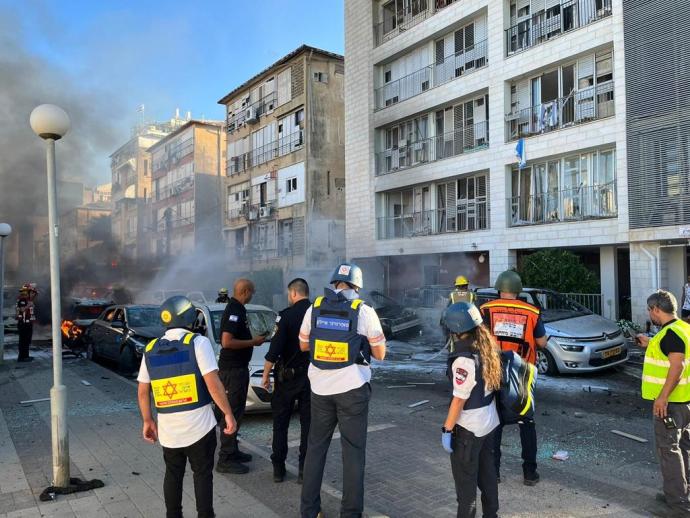“When an emergency occurs,” says Uri Shacham, Director General’s Office Chief of Staff at Magen David Adom, “everyone runs to their tasks ready to save lives. It’s in our DNA.”
While the events of October 7 caught everyone in Israel by surprise, Magen David Adom (MDA), Israel’s National Emergency Medical and Blood Services Organization had emergency teams arriving first at the scene.
During the weekend of Simchat Torah, MDA was on higher alert than normal days. This fact made it possible to quickly mobilize tens of thousands of its volunteers around the country as the terror attack began, both to join the first responders that were already in the south of Israel and provide immediate, life-saving treatment under fire and to also quickly man the entire fleet of 1,400 ambulances in preparedness for any developments from the Lebanese border.

On that black Saturday, the 101 MDA Emergency Call Center received tens of thousands of calls. It was the first organization to receive information about the casualties and reported immediately to the IDF. When the picture of the invasion became clear, MDA initiated special response mechanisms to provide life-saving care in the chaotic situation:
- Additional ambulances, helicopters, and bulletproof ambulances were deployed to the south of Israel to evacuate the casualties, even under fire.
- MDA stations in Ofakim, Sderot, and Netivot were converted to multi-casualty treatment centers, providing medical care to civilians, police officers, and soldiers who were injured while fighting Hamas terrorists.
- On some occasions, MDA volunteers turned their own homes and even a synagogue into field hospitals using the advanced equipment they held as first responders to provide life-saving treatment.
- As Israel’s National Blood Services Organization, MDA began operations to supply blood to the IDF and the hospitals across the entire country from the national emergency stock, which MDA holds for the benefit of the state and the Israel Defense Forces. This supply was immediately restocked thanks to the many thousands of people who donated blood in the first few hours and days of the war.
- To ensure the blood supply for the coming days, MDA immediately launched an emergency blood campaign and collected more than 15,000 units of blood, 3,700 of them on October 7.

MDA has the largest and most diverse range of volunteers and a wide array of rescue vehicles in Israel, which are always ready to provide immediate response in any emergency or war. They were the first at the scenes on October 7. The ability of MDA to respond from 0 to 100 in a few seconds is quite extraordinary. There is no organization like it in the world. MDA does not receive a budget from the Israeli government and is heavily supported by donations from Israel and abroad.
“In events such as this,” adds Orly Ariel, general director of Israeli Friends of Magen David Adom, “the organization that responds the fastest is Magen David Adom. We witnessed this during Covid 19 and now as well.” On the morning of October 7, thousands of emergency calls began flooding into MDA’s emergency dispatch centers. Magen David Adom has 32,000 volunteers spread throughout Israel. That morning, MDA personnel were ready and on high alert in kibbutzim and towns throughout Israel’s south, including Be’eri, Sderot, and Ofakim.
Here are some of the stories of MDA’s heroes:
Haim Rubin
Haim Rubin, an MDA paramedic, saved dozens of lives by evacuating the wounded under gunfire. “We drove through the fields to avoid encounters with terrorists because we understood that the other roads were threatened and unsafe, and on the way, we heard over the radio that two ambulances had been hit. We met a Duvdevan soldier (the elite Counter-Terrorism Commando Unit) who said that a few minutes earlier, he had encountered terrorists on motorcycles wearing IDF uniforms. They fired at him, and he fled through the fields. All this happened on the way to Moshav Naveh. We went there because we realized that the route there was relatively secure. When we arrived at the Beit Midrash (study hall) in Naveh, we saw that everything had been arranged for the Simchat Torah holiday. We moved all the benches to set up a triage and treatment site with signs and areas for mild, moderate, and severe injuries. In the center, we placed tables with medical equipment and signs directing the vehicles bearing the wounded.
“I was sure I was going to die. I felt that way when we were in Naveh, and every time I closed my eyes, I thought that any minute, they would get me. I’m a paramedic in the South Hebron Hills. I’ve been to almost all the attacks in the area, but the feeling here was different.”
Adam and Meitar
Adam and Meitar woke up at 6:30 AM to the sound of sirens and rocket barrages, never imagining what the next few hours of their lives would look like. They recently moved to Netivot, and even as new residents, they quickly realized that the images and the sound of machine-gun fire were clear and ominous.
At 7:30 AM, an hour after the attack began, and after he had already treated more than ten casualties, Meitar joined Adam with her paramedic bag. As it became evident that many casualties were coming to Netivot West Junction, they coordinated with MDA 101 emergency dispatch to establish a primary care point at this location. They provided immediate life-saving medical treatment, amid constant sirens, to the dozens of wounded who reached them in private vehicles from the Nova music festival that ended in the massacre.
When the first wave of the wounded ended, Adam and Meitar joined several evacuations of severely injured people to Soroka Hospital, traveling back and forth in MDA ambulances.
In the afternoon, security forces pursued terrorists who stole a vehicle belonging to one of the security coordinators and sped from Sderot to Netivot. The terrorists passed Meitar and Adam and the wounded who were with them and fired in their direction. Miraculously, they were not hurt.
MDA Helicopter Rescue
Ziv Shapira and Dr. Shafir Botner, paramedics at the MDA Helicopter division, described the events. “We woke up at 6:30 AM, like everyone else, with explosions from rocket fire. By 8:30, we were already in the air, evacuating casualties non-stop. We took a short break to refresh and restock the helicopter syringes with medications and equipment to be prepared to treat all kinds of wounds. We changed our uniforms because they were covered in blood, and headed back. On Saturday afternoon, we landed at a location that was under threat, but we were told that there were three critically wounded on the ground that we must evacuate, or they wouldn’t survive. In the air, on the way to the hospital, during the 15 or 20 minutes of flight, we did everything: we administered plasma, performed procedures, started IVs, treated with fluids, bandaged, and placed arterial tourniquets. In the air, we discovered we were transporting a young girl from the festival, a policeman who was shot in the leg by an RPG, and another policeman who was shot in the abdomen. Rockets were flying over our heads.
“Within 10 seconds, we heard a massive explosion, and I was sure we had been hit by a rocket. The helicopter started spinning in all directions. I was able to hold myself and scream on the radio that we were hit. Later, I discovered debris hit the rotor while the engine was running. The helicopter lost its balance, and if it weren’t for our incredible and superb pilots, I wouldn’t have been here today.”
MDA has the best independent response capabilities in the world for immediate extreme scenarios, giving the people of Israel the necessary resilience and the confidence that there is someone to rely on.

And there are some who, tragically, did not survive that day, such as:
Twenty-two-year-old Amit Man, an MDA paramedic and a paramedic instructor, was on duty in Kibbutz Be’eri on October 7. When the first sirens rang out, Man ran to the clinic to begin treating the wounded, and she continued doing so throughout the day. Man remained in contact with MDA’s operational headquarters and insisted on staying in Be’eri despite the danger. “As time passed, Amit realized that the situation was dire, but she didn’t lose hope,” says Shacham. Even though Amit herself was wounded, she continued to treat the injured. Later that day, Hamas terrorists broke into the clinic and murdered Man. Her body was found with a tourniquet on her thigh and her examination gloves on her hands. She was treating patients until the very last moments of her life.
Aharon Chaimov, a resident of Ofakim, was a Senior EMT and ambulance driver for MDA. At 7:00 AM, a call came into the MDA center reporting that civilians were under attack near Urim, a five-minute drive from Ofakim. Chaimov left his wife and children and drove to the scene to help. As he headed through the streets of Ofakim to evacuate the wounded, he found a group of Hamas terrorists blocking the road, who began shooting at his ambulance. He neutralized two of the terrorists but, tragically, was murdered by the remaining terrorists.
Sixty-nine-year-old Aviya Hezroni was known as the legendary ambulance driver of Kibbutz Be’eri. He volunteered for over 20 years in MDA and served as a Senior EMT. Despite his age, Hezroni continued his volunteer work for MDA, saying he wanted to serve as an example for the younger generation. When the shooting started in Be’eri, he set out for the clinic to help Amit Man treat the wounded but was shot and murdered by the Hamas terrorists on his way to the clinic.
They exemplify the spirit of sacrifice to save lives, even at the cost of sacrificing their own lives.
Itamar Abramovich, MDA Director of Volunteers and Training, says that hundreds of events of bravery and heroism by MDA volunteers took place on that black October day. “At 6:30 AM that morning,” he recalls, “we were switching shifts. As the night shift ended, the morning shift was coming on duty. At 7:00 AM, they told us to be on the highest alert and ordered all volunteers to report to the MDA stations.” Within an hour, 1,400 MDA ambulances were ready. Abramovich points out that at that time, it was unclear if the threats to Israel’s security were limited to Israel’s south, so Magen David Adom was prepared across all sectors of the country.
When the reports of the attacks in the south came in, Magen David Adom quickly mobilized fourteen bulletproof ambulances and traveled south. “MDA volunteers responded immediately and evacuated the wounded for treatment dozens of times under fire,” he says.
Yet another MDA team found itself at the police station in Sderot, where fierce gun battles with Hamas terrorists were taking place. The EMT saw a wounded police officer in the street, and his eyes locked on a Hamas sniper nearby. Staring danger in the face, the medic exited his ambulance and dragged the wounded man to safety without hesitation.
“Because of our dedicated volunteers,” says Abramovich, “we can rapidly deploy all our ambulances and medi-cycles within seconds. When Israel’s residents enter the bomb shelters, our volunteers are on the move, entering the inferno. These are the heroes of MDA. They are not soldiers or warriors. They are people with families and young children who made the decision to leave everything, including their families, in order to save lives. There was great heroism on this day, led by MDA’s fighters for life.”
